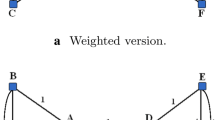Abstract
The paper is devoted to game-theoretic methods for community detection in networks. The traditional methods for detecting community structure are based on selecting denser subgraphs inside the network. Here we propose to use the methods of cooperative game theory that highlight not only the link density but also the mechanisms of cluster formation. Specifically, we suggest two approaches from cooperative game theory: the first approach is based on the Myerson value, whereas the second approach is based on hedonic games. Both approaches allow to detect clusters with various resolution. However, the tuning of the resolution parameter in the hedonic games approach is particularly intuitive. Furthermore, the modularity based approach and its generalizations can be viewed as particular cases of the hedonic games.
Access this chapter
Tax calculation will be finalised at checkout
Purchases are for personal use only
Similar content being viewed by others
References
Avrachenkov, K., Dobrynin, V., Nemirovsky, D., Pham, S.K., Smirnova, E.: Pagerank based clustering of hypertext document collections. In: Proceedings of ACM SIGIR 2008, pp. 873–874 (2008)
Avrachenkov, K., El Chamie, M., Neglia, G.: Graph clustering based on mixing time of random walks. In: Proceedings of IEEE ICC 2014, pp. 4089–4094 (2014)
Blatt, M., Wiseman, S., Domany, E.: Clustering data through an analogy to the Potts model. In: Proceedings of NIPS 1996, pp. 416–422 (1996)
Blondel, V.D., Guillaume, J.L., Lambiotte, R., Lefebvre, E.: Fast unfolding of communities in large networks. J. Stat. Mech. Theory Exp. 10, P10008 (2008)
Bogomolnaia, A., Jackson, M.O.: The stability of hedonic coalition structures. Games Econ. Behav. 38(2), 201–230 (2002)
Dongen, S.: Performance criteria for graph clustering and Markov cluster experiments. CWI Technical report (2000)
Fortunato, S.: Community detection in graphs. Phys. Rep. 486(3), 75–174 (2010)
Fortunato, S., Barthelemy, M.: Resolution limit in community detection. Proc. Nat. Acad. Sci. 104(1), 36–41 (2007)
Girvan, M., Newman, M.E.J.: Community structure in social and biological networks. Proc. Nat. Acad. Sci. USA 99(12), 7821–7826 (2002)
Jackson, M.O.: Allocation rules for network games. Games Econ. Behav. 51(1), 128–154 (2005)
Jackson, M.O.: Social and Economic Networks. Princeton University Press, Princeton (2008)
Leskovec, J., Lang, K.J., Dasgupta, A., Mahoney, M.W.: Community structure in large networks: Natural cluster sizes and the absence of large well-defined clusters. Internet Math. 6(1), 29–123 (2009)
Mazalov, V.: Mathematical Game Theory and Applications. Wiley, Hoboken (2014)
Mazalov, V., Avrachenkov, K., Trukhina, I.: Game-theoretic centrality measures for weighted graphs. Fundamenta Informaticae 145(3), 341–358 (2016)
Mazalov, V.V., Trukhina, L.I.: Generating functions and the Myerson vector in communication networks. Disc. Math. Appl. 24(5), 295–303 (2014)
Meila, M., Shi, J.: A random walks view of spectral segmentation. In: Proceedings of AISTATS 2001
Myerson, R.B.: Graphs and cooperation in games. Math. Oper. Res. 2, 225–229 (1977)
Newman, M.E.J.: A measure of betweenness centrality based on random walks. Proc. Nat. Acad. Sci. USA 27, 39–54 (2005)
Newman, M.E.J.: Modularity and community structure in networks. Soc. Netw. 103(23), 8577–8582 (2006)
Pons, P., Latapy, M.: Computing communities in large networks using random walks. J. Graph Algorithms Appl. 10(2), 191–218 (2006)
Raghavan, U.N., Albert, R., Kumara, S.: Near linear time algorithm to detect community structures in large-scale networks. Phys. Rev. E 76(3), 036106 (2007)
Reichardt, J., Bornholdt, S.: Statistical mechanics of community detection. Phys. Rev. E 74(1), 016110 (2006)
von Luxburg, U.: A tutorial on spectral clustering. Stat. Comput. 17(4), 395–416 (2007)
Waltman, L., van Eck, N.J., Noyons, E.C.: A unified approach to mapping and clustering of bibliometric networks. J. Inform. 4(4), 629–635 (2010)
Zachary, W.W.: An information flow model for conflict and fission in small groups. J. Anthropol. Res. 33(4), 452–473 (1977)
Acknowledgements
This research is supported by Russian Humanitarian Science Foundation (project 15-02-00352), Russian Fund for Basic Research (projects 16-51-55006 and 17-11-01079), EU Project Congas FP7-ICT-2011-8-317672 and Campus France.
Author information
Authors and Affiliations
Corresponding author
Editor information
Editors and Affiliations
Rights and permissions
Copyright information
© 2017 Springer International Publishing AG
About this paper
Cite this paper
Avrachenkov, K.E., Kondratev, A.Y., Mazalov, V.V. (2017). Cooperative Game Theory Approaches for Network Partitioning. In: Cao, Y., Chen, J. (eds) Computing and Combinatorics. COCOON 2017. Lecture Notes in Computer Science(), vol 10392. Springer, Cham. https://doi.org/10.1007/978-3-319-62389-4_49
Download citation
DOI: https://doi.org/10.1007/978-3-319-62389-4_49
Published:
Publisher Name: Springer, Cham
Print ISBN: 978-3-319-62388-7
Online ISBN: 978-3-319-62389-4
eBook Packages: Computer ScienceComputer Science (R0)




